Enlargement countries - labour market statistics
Data extracted in May 2023.
Planned article update: May 2024.
Highlights
In 2021, employment rates for women were below 50 % in five of the Western Balkans and Türkiye: North Macedonia (49.2 %), Montenegro (48.7 %), Bosnia and Herzegovina (39.1 %), Türkiye (34.1 %) and Kosovo (18.5 %). In the EU, the rate was 67.7 %.
In Albania, 33.8 % of the labour force were working in agriculture, forestry and fisheries in 2021. In the EU, the share was 3.8 %.
In 2021, among the Western Balkans and Türkiye, self-employed and family workers ranged between 14.9 % in Bosnia and Herzegovina and 52.1 % in Albania, whereas it was 13.7 % in the EU.
Activity rates of persons aged 20-64 years, 2011-2021
This article is part of an online publication and provides information on a range of labour market statistics for the Western Balkans and Türkiye and compares this with the corresponding data for the European Union (EU). Within this region, Bosnia and Herzegovina, Montenegro, North Macedonia, Albania, Serbia and Türkiye are candidate countries, while Kosovo has the status of potential candidate.
Data for Georgia, Moldova and Ukraine, granted candidate status or European perspective by the European Council in June 2022, are not included in this article; Statistics Explained articles on the European Neighbourhood Policy-East countries are available here.
The article provides an overview of the labour force characteristics, covering indicators such as activity rates, employment rates, and unemployment rates, as well as an analysis of the workforce by economic activity.
* This designation is without prejudice to positions on status, and is in line with UNSCR 1244/1999 and the ICJ Opinion on the Kosovo Declaration of Independence.
Full article
Activity rates
The economically active population, also known as the labour force, comprises employed and unemployed persons. The labour force also includes people who were not at work but had a job or business from which they were temporarily absent, for example because of illness, holidays, industrial disputes, education or training. The activity rate is the proportion of the population who are economically active.
Figure 1 presents, for the Western Balkans and Türkiye as well as for the EU, the proportion of the economically active population aged 20-64 years for 2011 and 2021, disaggregated to show the activity rates for men and women.
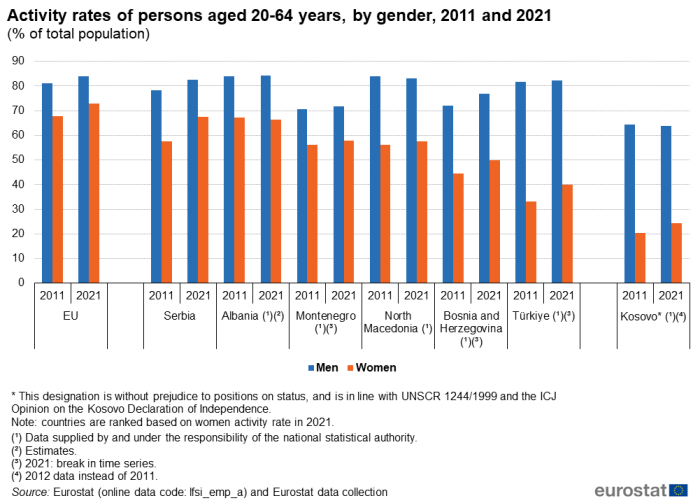
(% of total population)
Source: Eurostat (lfsi_emp_a) and Eurostat data collection
Activity rates in most of the Western Balkans (Serbia, Montenegro, Bosnia and Herzegovina) and Türkiye increased from 2011 to 2021 both for men and women. Western Balkans and Türkiye recorded an increase of the activity rate for men: Bosnia and Herzegovina 4.7 percentage points (pp), Serbia 4.3 pp, Montenegro 1.1 pp, Türkiye, 0.6 pp and Albania 0.2 pp. The only two countries which recorded the decline in men's activity rate were North Macedonia -0.7 pp and Kosovo, -0.5 pp (between 2012 and 2021). Activity rates for women were lower than in the EU both in 2011 and 2021; this also was true for men in 2021, except for Albania (0.2 pp higher than in the EU). Activity rates increased more for women than for men between 2011 and 2021 throughout the region, as in the EU, so that the gender gap declined everywhere, except Albania.
Activity rates for women in the Western Balkans and Türkiye were highest in 2021 in Serbia, at 67.4 %; Albania, at 66.3 %; Montenegro, at 57.8 %; and in North Macedonia, at 57.4 %. Women aged 20-64 years who were either working or available for work accounted for 50.0 % of the labour force in Bosnia and Herzegovina; 40.0 % in Türkiye and 24.4 % in Kosovo. The EU women activity rate in 2021 was 72.9 %.
Activity rates for men in some of the Western Balkans and Türkiye in 2021 were at similar levels to the 84.0 % recorded in the EU. In Albania and North Macedonia, the activity rates for men were 84.2 % and 83.2 %, respectively. Serbia, at 82.6 % and, Türkiye at 82.3 %, were not far behind. Men activity rates were lower in Bosnia and Herzegovina at 76.7 %, in Montenegro at 71.7 %, and in Kosovo, at 63.8 %.
A comparison between activity rates for men and women in 2021 across the Western Balkans and Türkiye shows that the widest labour force gender gaps were recorded in Türkiye and in Kosovo, 42.3 pp and 39.4 pp, where activity rates for women were (42.3 pp and 39.4 pp, respectively) lower than the corresponding rates for men. Between 2011 and 2021, the gender gap had fallen by 6.3 pp in Türkiye; and by 4.6 pp in Kosovo (between 2012 and 2021). In Bosnia and Herzegovina, the activity rate gender gap was 26.7 pp in 2021, a fall of 0.7 pp from 2011, while in North Macedonia it was 25.7 pp, resulting in a gender gap decrease of 2.0 pp. Albania's gender gap in 2021 was 17.8 pp, up by 1.1 pp from 2011. Serbia's gender gap was 15.2 pp, a decrease of 5.5 pp; and Montenegro's was at the similar level at 13.9 pp, a decline of 0.5 pp between 2011 and 2021.
The EU activity gender gap in 2021 was 11.1 pp, 2.4 pp below the corresponding figure for 2011.
Employment rates
In line with international standards, the EU Labour force survey (EU LFS) defines persons in employment as those aged 15 years and over, who, during the reference week, performed some work, even for just one hour per week, for pay, profit or family gain. Employment statistics are frequently reported as employment rates to discount the changing size of countries' populations over time and to facilitate comparisons between countries of different sizes. These rates are typically published for the working age population, which is generally considered to be those aged 15-64 years, as well as for those aged 20-64 years, in order to take account of the increasing proportion of young people who remain in education. The data presented in Figure 2 show employment rates in 2011 and 2021 by gender for the 20-64 years age group for the Western Balkans and Türkiye, as well as for the EU.
Since people in employment make up a large part of the labour force, statistics about these two categories often increase or decrease together. Comparisons can therefore be made between Figure 1 and Figure 2.
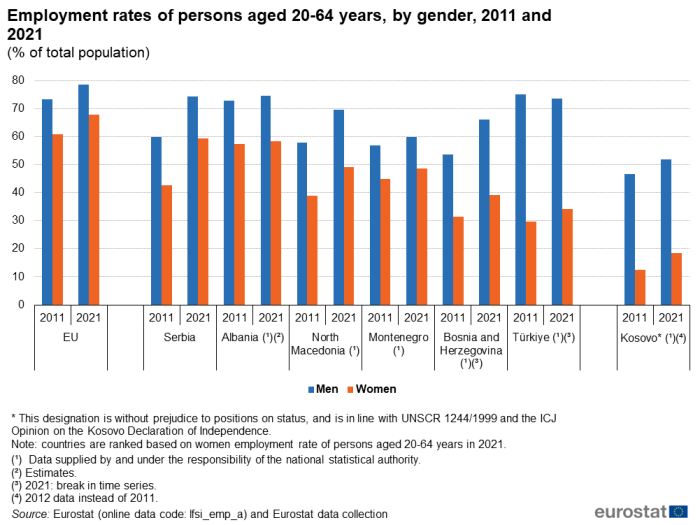
(% of population)
Source: Eurostat (lfsi_emp_a) and Eurostat data collection
The highest men employment rate in 2021 among the Western Balkans and Türkiye was 74.6 % in Albania, where the women employment rate was 58.3 %. Men employment had increased by 1.8 pp from 2011, women by 1.1 pp, meaning that the gender gap had widened by 0.7 pp up to 16.3 pp.
Serbia reported an employment rate for men in 2021 at 74.2 %, and for women at 59.3 %. From 2011, men employment had increased by 14.4 pp and women by 16.7 pp, narrowing the gender gap by 2.3 pp to 14.9 %.
Türkiye in 2021 saw a men employment rate of 73.6 % and a women employment rate of 34.1 %. Men employment decreased from 2011 by 1.5 pp while that for women increased by 4.3 pp. The gender gap thus narrowed by 5.8 pp to 39.5 %.
In North Macedonia in 2021, the men employment rate was 69.5 % and that for women, 49.2 %. From 2011, both men and women employment had increased but not equally, by 11.8 pp and 10.4 pp, respectively, so that the gender gap increased by 1.3 pp, to 20.3 %.
Bosnia and Herzegovina had a men employment rate of 66.0 % in 2021 and a women rate of 39.1 %. Men employment had gone up by 12.3 pp from 2011 and the women rate by 7.7 pp, so that the gender gap widened by 4.6 pp to 26.9 pp over the ten years.
The Montenegro men and women employment rates were 59.8 % and 48.7 %, respectively, in 2021. The men and women employment rates had risen by 3.0 pp and 3.7 pp, respectively, from 2011, decreasing the gender gap by 0.7 pp to 11.1 %, the lowest among the Western Balkans and Türkiye.
In Kosovo in 2021, men employment stood at 51.9 %, while the women employment rate was 18.5 %. The gender gap was therefore 33.4 pp, 0.8 pp narrower than in 2012, due to an increase of both men and women employment rates over the period by 5.3 pp and 6.1 pp, respectively.
By comparison, the EU employment rate for men stood at 78.5 % in 2021, higher than the corresponding rate for women, 67.7 %. Furthermore, men and women employment rate had increased by 5.1 and 6.8 pp, respectively, compared with 2011, so that the gender gap decreased by 1.7 pp to 10.8 pp.
Analysis of employment by economic activity
Figure 3 shows an analysis of the structure of employment for 2011 and 2021 by broad economic activities.
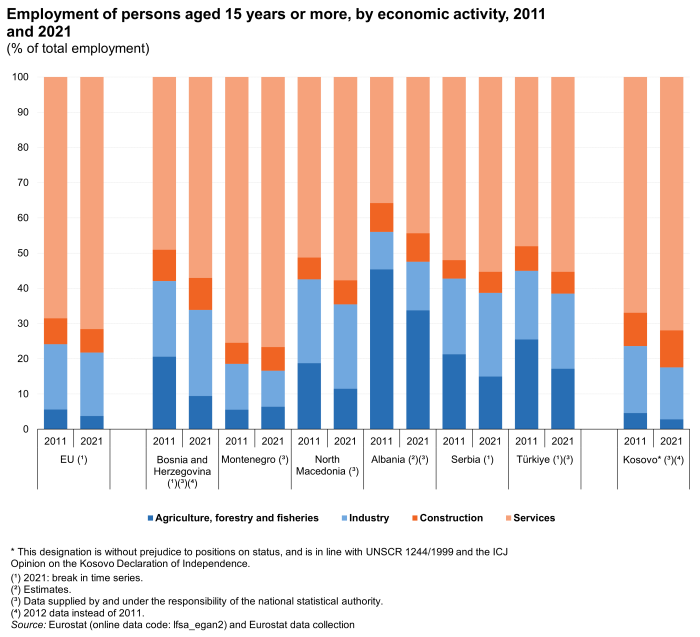
(% of total employment)
Source: Eurostat (lfsa_egan2) and Eurostat data collection
In almost all the Western Balkans and Türkiye, services accounted for the largest proportion of the workforce in both 2011 (or 2012, depending on data availability) and 2021, except for Albania in 2011. In 2021, services accounted for more than half of all people employed in all the economies of the region except for Albania, where the share was 44.3 %. The employment share of services in 2021 in Montenegro, at 76.7 %, and in Kosovo, at 71.9 % were notably higher than elsewhere in the region. In Serbia and Türkiye, the share of services in employment increased between 2011 and 2021, from 52.0 %, to 55.3 % and from 48.1 % to 55.3 %, respectively. Albania recorded the highest growth of the share of services over decade, from 35.8 %, to 44.3 %, by 8.6 pp, followed closely by Bosnia and Herzegovina from 49.1 %, to 57.0 %, by 7.9 pp and Türkiye from 48.1 %, to 55.3 %, by 7.2 pp.
A relatively high share of the total workforce was employed in agriculture, forestry and fisheries in Albania, where it was the second largest employer in 2021 with a share of employment of 33.8 %. Agriculture, forestry and fisheries was also a significant employer in most of the other Western Balkans and Türkiye except for Kosovo (2.8 %) and Montenegro (6.4 %). Employment in this activity fell during the period 2012 to 2021 in Bosnia and Herzegovina (no data for 2011) from 20.6 % to 9.4 %; and in Türkiye, from 25.5 % to 17.2 %. In all Western Balkans and Türkiye Agriculture, except Albania, forestry and fisheries fell below employment in the industry sector, which became the second largest employer in 2021.
The countries of the region can be divided into two broad groups by their share of people employed by industry in 2021. The first includes Bosnia and Herzegovina with a 24.4 % share; North Macedonia with 23.9 %; Serbia with 23.7 %; and Türkiye with 21.3 %. The second comprises Kosovo with 14.8 % share of employment; Albania with 13.8 %; and Montenegro, with 10.2 %. Note that for Bosnia and Herzegovina, Serbia, and Türkiye, 2021 was a break in time series. The share of employment in industry was more or less stable, recording only small increases or decreases over the period 2011 (2012, depending on the data availability) and 2021 in all Western Balkans and Türkiye, the highest decrease was in Kosovo by 4.2 pp between 2012 and 2021.
Services employed 71.6 % of the EU's workforce in 2021, being a break in time series. Industry had the second largest share, with 18.0 % of total employment, while the shares of employment in construction, at 6.6 % and in agriculture, forestry and fisheries, 3.8 %, were much lower.
Analysis of employment by working status
Figure 4 shows the shares of employment by working status: employees, self-employed and family workers for the Western Balkans and Türkiye, as well as the EU.
Self-employed and family workers together accounted for 52.1 % of total employment in Albania in 2021, reflecting, to some degree, the relative weight of agricultural activities, with work spread across numerous small-scale holdings. Self-employment and family work were significant also in the other Western Balkans and Türkiye in 2021: Türkiye with 30.1 % of total employment, Kosovo 22.2 %, Serbia 20.5 %, Montenegro 19.1 % and Bosnia and Herzegovina 14.9 %. Again, note that 2021 was a break in time series for Bosnia and Herzegovina, Serbia, and Türkiye. No data available for North Macedonia in 2021.
In most of the Western Balkans and Türkiye, the share of self-employment and family work declined between 2011 and 2021, in particular in Bosnia and Herzegovina, where it fell by 10.3 pp; and in Albania and Türkiye, where it fell by 9.0 pp and 8.2 pp, respectively. Serbia also recorded a decrease between 2011 and 2021 (-7.1 pp). In Montenegro, the share of self-employment and family work increased over 2011-2021 by 2.7 pp, while in Kosovo it decreased over 2012 (no 2011 data) and 2021 by 3.4 pp. Data for 2021 are not available North Macedonia, thus no conclusion can be drawn regarding the development over time.
In the EU in 2021, 13.7 % of people in employment were self-employed or family workers. The vast majority of the workforce (86.3 %) were therefore employees. The share of the self-employed and family workers in total employment in the EU declined during the period 2011-2021 by 2.5 pp.
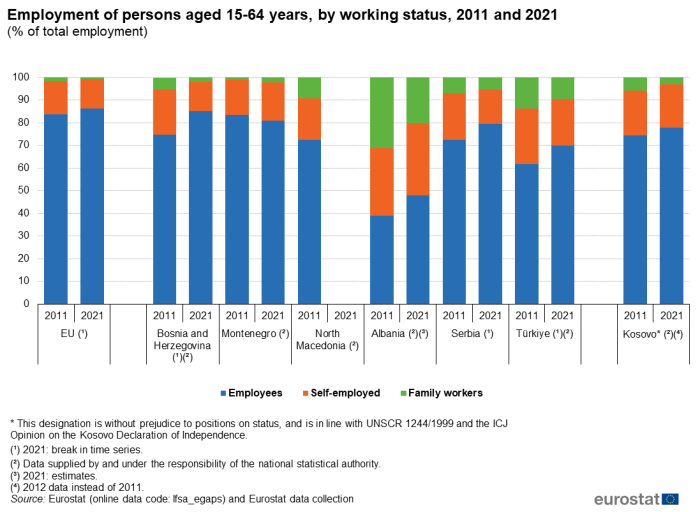
(% of total employment)
Source: Eurostat (lfsa_egaps) and Eurostat data collection
Unemployment rates
Eurostat publishes unemployment statistics based on the definition of unemployment provided by the International Labour Organisation (ILO), for which there are three criteria: being without work, actively seeking work, and being available for work. Therefore, people working only a few hours a week and who wish to work more, known as the underemployed, are excluded from the unemployment figures. The unemployment rate is the number of unemployed divided by the labour force.
In countries that have significant underemployment, understanding of the unemployment data benefits from being read in conjunction with employment data. If statistics are compiled on part-time work or on total hours worked, it may be possible to identify trends in underemployment.
In general, the unemployment rate begins to rise only some time after an economic downturn has occurred. Once the economy starts to pick up again, employers usually remain cautious about hiring new workers and there may be a lag before the unemployment rate start to fall. In addition, people who were formerly economically inactive join or rejoin the labour force, initially increasing the unemployment figures.
Data for the Western Balkans and Türkiye on unemployment rates, as well as the EU, is shown in Figure 5 for the period 2011-2021.
Unemployment rates hit their high points for the 2011-2021 period in the years 2014 in Kosovo (35.3 %) and Albania (17.5 %); 2012 in Montenegro (19.7 %), Bosnia and Herzegovina (28.2 %) and Serbia (24.1 %); 2011 in North Macedonia (31.4 %); and 2019 in Türkiye (13.7 %). The EU had its unemployment peak in 2013 (11.4 %). Unemployment rates over the period 2011-2021 reached their lows in 2019 in three of the Western Balkans countries as well as in the EU, approximately eleven years after the global financial crisis. North Macedonia and Kosovo reached their lowest points in 2021, Serbia had its lowest unemployment rate in 2020, while for Türkiye the lowest rate was already in 2012.
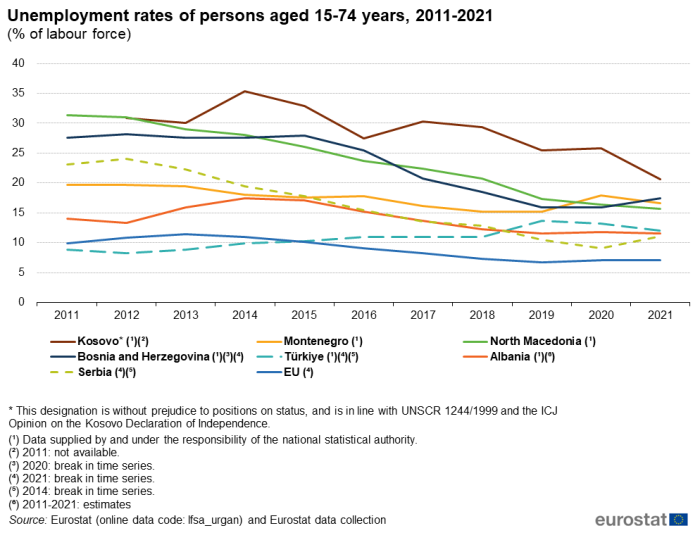
(% of labour force)
Source: Eurostat (lfsa_urgan) and Eurostat data collection
The highest unemployment rate in 2021 in the Western Balkans and Türkiye was recorded in Kosovo, at 20.6 %. Bosnia and Herzegovina, next highest, was far behind at 17.4 %, followed by Montenegro, at 16.6 % and North Macedonia 15.7 %. Kosovo had the highest average unemployment rate over the period 2011-2021 (28.8 %, 2012-2021), followed by North Macedonia (23.8 %) and by Bosnia and Herzegovina (23.0 %).
In 2021, Türkiye's unemployment rate was 12.0 %. Its 2021 unemployment rate was exceptional among the Western Balkans and Türkiye as being above its 2011-2021 average rate (10.7 %). Albania's unemployment rate in 2021 was estimated at 11.6 % and Serbia's was at 11.1 %, the lowest among the Western Balkans and Türkiye. Serbia's average rate, at 16.3 %, was above those of both Albania (14.0 %) and Türkiye over the period 2011-2021. The EU unemployment rate in 2021 was 7.1 %, while its 2011-2021 average rate stood at 9.0 %.
Figure 6 disaggregates unemployment rates by gender for 2011 and 2021. In every case, women unemployment was higher than men, except for a fairly small difference in the other direction in North Macedonia and Montenegro in 2021. North Macedonia's gender gap decreased by 0.8 pp and Montenegro's by 1.7 pp from 2011, from women unemployment being 1.0 pp lower than men in 2011 to being 1.8 pp lower in 2021 in North Macedonia, and 0.5 pp higher than men in 2011 to being 1.2 pp lower in 2021 in Montenegro.
Bosnia and Herzegovina's unemployment gender gap in 2021 was 7.6 %, followed by Kosovo (6.0 %) they both were by far the largest in the region, despite a decrease of that of Kosovo by 5.9 pp from 2012 (no data for 2011) and being also the greatest gender gap change. Türkiye saw an increase in the gender gap by 2.3 pp to 4.1 pp in 2021.
The gender gap for unemployment was 0.4 % in Albania in 2021, having decreased by 0.4 pp from 2011. Serbia's unemployment gender gap was 1.9 % in 2021, having increased by 0.5 pp from 2011. Bosnia and Herzegovina had the second largest gender gap change in 2021 with 7.6 %, an increase of 3.8 pp from 2011. The unemployment gender gap in the EU in 2021 was 0.7 %, an increase of 0.3 pp from 2011.
The decreases of unemployment rates of persons aged 15-74 years for both genders were recorded in all Western Balkans and EU over the decade. The only exception was Türkiye, where the rates of unemployment were the lowest in 2011 but increased for both genders over decade.
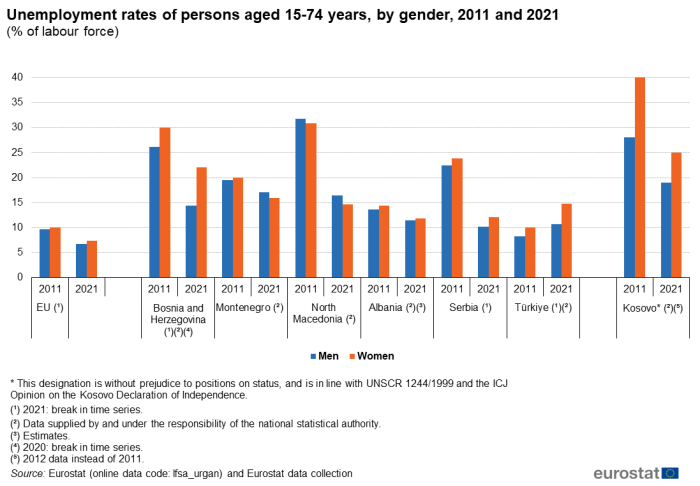
(% of labour force)
Source: Eurostat (lfsa_urgan) and Eurostat data collection
Source data for tables and graphs
Data sources
The main source for European labour force statistics is the European Union labour force survey (EU LFS). This household survey is carried out in all EU Member States in accordance with European legislation; it provides figures at least every quarter. Some of the Western Balkans and Türkiye (Montenegro, North Macedonia, Serbia and Türkiye) also conduct the labour force survey according to the same guidelines and their data is available free-of-charge, together with the EU data, on Eurostat's website.
Data for the enlargement countries are collected for a wide range of indicators each year through a questionnaire that is sent by Eurostat to Western Balkans and Türkiye. A network of contacts has been established for updating these questionnaires, generally within the national statistical offices, but potentially including representatives of other data-producing organisations, for example, central banks or government ministries. LFS data for Albania, Bosnia and Herzegovina and Kosovo are collected via these questionnaires.
The economically active population (labour force) comprises employed and unemployed persons, but not the economically inactive, for example children, students and pensioners as well as people caring for family members; some of these may be of working-age.
Context
Labour market statistics are increasingly used to support policymaking and to provide an opportunity to monitor participation in the labour market. In the aftermath of the global financial and economic crisis, these statistics are used to monitor the effects of the crisis on labour markets, which tend to lag behind changes in economic activity.
Social policymakers often face the challenge of remedying uncertainty in employment and high unemployment by designing ways to increase employment opportunities for specific groups in society, such as the young, those having working in certain economic activities, or those living in low employment regions.
The slow pace of recovery from the financial and economic crisis in the EU and mounting evidence of rising unemployment led the European Commission to propose an employment package in April 2012. This considered how employment policies intersect with a number of other policy areas in support of smart, sustainable and inclusive growth. It identified the EU's largest job potential areas and the most effective ways for EU countries to create more jobs.
In December 2012, in the face of high and still rising youth unemployment in several EU Member States, the European Commission proposed a Youth employment package (COM(2012) 727 final). Efforts to reduce youth unemployment continued in 2013 as the European Commission presented a Youth employment initiative (COM(2013) 144 final) designed to reinforce and accelerate measures outlined in the Youth employment package. It aimed to support, in particular, young people not in education, employment or training in regions with a youth unemployment rate above 25 %. There followed another Communication Working together for Europe's young people — A call to action on youth unemployment (COM(2013) 447 final) which was designed to accelerate the implementation of the youth guarantee and provide help to EU Member States and businesses so they could recruit more young people.
In June 2016, the European Commission adopted a Skills Agenda for Europe (COM/2016/0381 final) under the heading 'Working together to strengthen human capital, employability and competitiveness'. This was intended to ensure that people develop the skills necessary for now and the future, in order to boost employability, competitiveness and growth across the EU.
The open method of coordination (OMC) enables the coordination of the EU Member States' employment policies towards common objectives for the labour market, without requiring binding European legislative measures. Through the peer reviews and the central role of the Council, it helps spreading good practices among EU Member States and achieving greater convergence towards the main EU goals. The OMC process for national employment policies is an integral part of the annual European Semester cycle of economic policy coordination.
Information concerning the current statistical legislation on labour market statistics can be found here.
While basic principles and institutional frameworks for producing statistics are already in place, the enlargement countries are expected to increase progressively the volume and quality of their data and to transmit these data to Eurostat in the context of the EU enlargement process. EU standards in the field of statistics require the existence of a statistical infrastructure based on principles such as professional independence, impartiality, relevance, confidentiality of individual data and easy access to official statistics; they cover methodology, classifications and standards for production.
Eurostat has the responsibility to ensure that statistical production of the enlargement countries complies with the EU acquis in the field of statistics. To do so, Eurostat supports the national statistical offices and other producers of official statistics through a range of initiatives, such as pilot surveys, training courses, traineeships, study visits, workshops and seminars, and participation in meetings within the European statistical system (ESS). The ultimate goal is the provision of harmonised, high-quality data that conforms to European and international standards.
Additional information on statistical cooperation with the enlargement countries is provided here.
Direct access to
- All articles on non-EU countries
- Enlargement countries — statistical overview — online publication
- Statistical cooperation — online publication
- All articles on the labour market
- Statistical books/pocketbooks
- Key figures on enlargement countries — 2019 edition
- Key figures on enlargement countries — 2017 edition
- Key figures on the enlargement countries — 2014 edition
- Factsheets
- Labour market statistics on candidate countries and potential candidates — Factsheets — 2023 edition
- Basic figures on the candidate countries and potential candidates — Factsheets — 2023 edition
- Basic figures on Western Balkans and Türkiye — Factsheets — 2022 edition
- Basic figures on enlargement countries — Factsheets — 2021 edition
- Leaflets
- Basic figures on enlargement countries — 2020 edition
- Basic figures on enlargement countries — 2019 edition
- Basic figures on enlargement countries — 2018 edition
- Basic figures on enlargement countries — 2016 edition
- Labour force statistics in Enlargement and ENP‑South countries — 2019 edition
- LFS main indicators (lfsi)
- Employment and activity - LFS adjusted series (lfsi_emp)
- Unemployment - LFS adjusted series (une)
- LFS series - detailed annual survey results (lfsa)
- Employment - LFS series (lfsa_emp)
- Employment rates - LFS series (lfsa_emprt)
- Total unemployment - LFS series (lfsa_unemp)
- LFS main indicators (ESMS metadata file — lfsi_esms)
- LFS series - detailed annual survey results (ESMS metadata file — lfsa_esms)
- EU labour force survey – main features and legal basis
- Youth employment package (COM(2012) 727 final)
- Youth employment initiative (COM(2013) 144 final)
- Working together for Europe's young people - A call to action on youth unemployment (COM(2013) 447 final)
- Recommendation on the integration of the long-term unemployed into the labour market